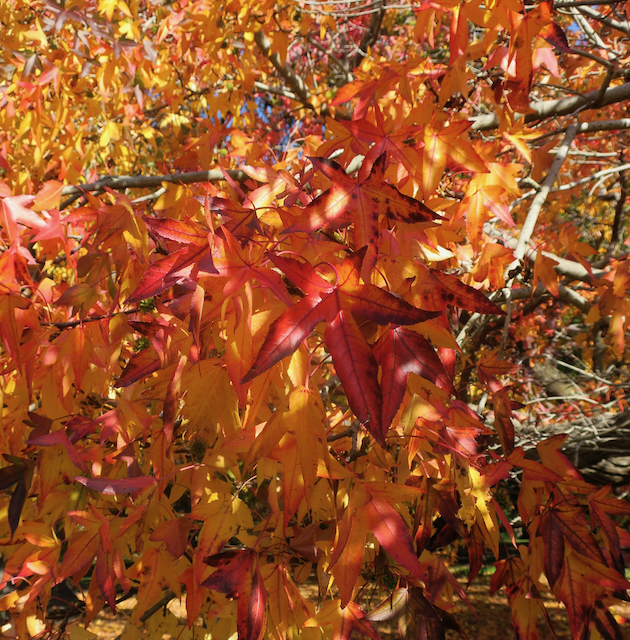The very large
Liquidambar liquidambar styraciflua in the Royal Botanic Garden Melbourne was looking splendid a couple of weeks ago. There was still some green in the canopy which, by now, is likely to have changed to autumn colours.
The tree looked particularly striking against the green of the oaks in the background.
This mass of orange and yellow leaves certainly gives justification to the "ambar/amber" part of the tree's name.
I was intrigued to find this small group of leaves and a single fruit growing directly from the bark of a large lichen encrusted branch. These colours really are inspiring. However, the sight also leaves me grateful that the majority of Australia's trees are evergreen.
*
I recently set my Melbourne students the exercise of making an ikebana with "Intertwining materials". The exercise is open to a variety of interpretations.
Marcia used some branches of dried Tortuous Willow Salix matsudana, which were interlocked. With these providing a strong structure, she then intertwined some fine stems of Jasmine Jasminum. A single Parrot Tulip Tulipa, creates a contrasting focal point.
Eugenia used some dry branches of Corky elm around which she twined an unknown vine with long catkins. On the left side are some stems of the leafless Acacia aphylla which were twined around themselves.
Jacqueline used two New Zealand Flax leaves and some dried vine that was already twisted onto itself. She split one of the flax leaves into five and then threaded the sections into the other materials. A single Gerbera was added as a floral focus
Marisha had two lengths of Wisteria vine that were too long to be supported from a single cylindrical vase, so a second one was brought into play. This meant that the vine could be extended and intertwined without the risk of it breaking. Two Asiatic Lilies were placed toward the back to maintain the focus on the vine.
My own ikebana this week is the product of a demonstration I gave in conjunction with the exhibition "Cutting Through Time" currently showing at the Geelong Gallery (until 28th July). The exhibition focuses on the work of two Australian artists: Cressida Campbell and Margaret Preston, both of whom were influenced by traditional Japanese wood block printing. I highly recommend this exhibition if you have the opportunity to visit Geelong.
My first ikebana is a large horizontally-spreading ikebana that represents the transition from autumn through to winter (reading right to left). The materials are Japanese maple Acer palmatum, Chrysanthemum and a bare branch of Magnolia. The wood-fired vessel by Sergio Sill has a Shino glaze.
I made this second ikebana as a direct reference to a detail in one of the woodblocks by Cressida Campbell. The image is of the artist's living room which shows many paintings and prints on the walls. It also contains a small image of a very tall glass vase with a single pink Hydrangea and some material beneath the water in the vase. I was struck by the ikebana "correctness" of the image. The element below the water surface is clearly a part of the whole ikebana and there is and uncluttered "space" at the bottom of the vessel.
Greetings from Christopher
26th May 2024









No comments:
Post a Comment